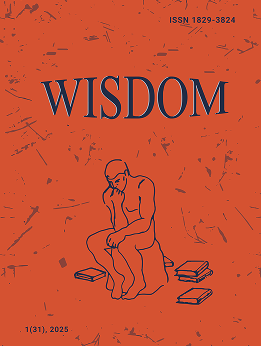Non-Verbal Communication and Cues in Armenian-American Literary Discourse
DOI:
https://doi.org/10.24234/wisdom.v9i2.192Keywords:
communication, nonverbal communication, literature, Armenian-American writers, nonverbal cues, literary techniques, identity, pain of loss, exile, alienationAbstract
Communication is foundation of life. Literature is a universal form of communication. Writers communicate beliefs, ideas, experiences, feelings and thoughts. Armenian-American literature is a huge source of communication. Armenian-American writers who migrated to the USA throughout various time periods bring unique storylines and techniques to literature. Nonverbal communication is known to be the more honest part of human communication. Understanding communication requires combined analysis of verbal and nonverbal communication. This research identifies features of nonverbal communication incorporated in literary texts. Nonverbal cues incorporated in literary texts are seemingly minor yet vital features which sometimes are left out of the readers’ attention.
The following literary works were chosen for the research: Peter Balakian’s Black Dog of Fate (1997, memoir), Micheline Aharonian Marcom’s Three Apples Fell from Heaven (2001, fiction). The chosen samples include writings which have not been widely analysed especially from communication theory aspects. The main analysis method utilized was close reading of the texts. Further, research can be done to analyse poetry collections to identify whether nonverbal cues are as significantly used in poetry as they are used in stories and novels.
Downloads
References
Andersen, P. A. (2007). Nonverbal communication: Forms and functions (2nd ed.). LongGrove, IL: Waveland Press.
Antreassian, J. (1981). The Armenian in America: A Personal Viewpoint. The Armenian Image in History and Literature. Malibu, CA: Undena Publications.
Ares, E. B., & Camping, J. (2012). World without Words. Amsterdam: Hogeschool van Amsterdam.
Avakian, A. (1977). The Armenians in America. Minneapolis: Learner Publications Company.
Aghanian, D. (2007). The Armenian Diaspora: Cohesion and Fracture. University Press of America.
Balakian, P. (1997). Black Dog of Fate.Basic Books.
Bar-on, D. & Chaitin, J. (2001). Parenthood and the Holocaust. Yad Vashem.
Bedrosian, M. (1991). The Magical Pine Ring: Culture and the Imagination in Armenian-American Literature. Detroit: Wayne State University Press.
Birdwhistell, R. L. (1970). Kinesics and Context. Philadelphia: University of Pennsylvania Press.
Cheterian, V. (2015). Open Wounds: Armenians, Turks and a Centruy of Genocide. Oxford University Press.
Ekman, P. (1978). Facial Expression.In A. W. Siegman & Feldstein (eds.), NonverbalBehavior and Communication.Hillsdale, NJ, Erlbaum.
Ekman, P. (1978). Facial Expression.In A. W. Siegman & Feldstein (eds.), Nonverbal Behavior and Communication. Hillsdale, NJ, Erlbaum.
Hall, J. A., & Knapp, M. L. (2013). Nonverbal Communication. Berlin: De Gruyter Mouton.
Kherdian, D. (2008). Forgotten Bread: First-Generation Armenian American Writers. Berkeley, CA: Heyday Books.
Marcom, M. (2001). Three Apples Fell from Heaven. New York: Riverhead books.
Mekhitarian, K. (1956). A Quarter Century of Armenian Literature Abroad.
Morris, D. (1977). Manwatching: A Field Guide to Human Behavior. New York, Harry N. Adams.
Oshagan, V. (1986). Literature of the Armenian Diaspora. Board of Regents of the University of Oklahoma.
Downloads
Published
How to Cite
Issue
Section
License
Creative Commons Attribution-Non-Commercial (CC BY-NC). CC BY-NC allows users to copy and distribute the article, provided this is not done for commercial purposes. The users may adapt – remix, transform, and build upon the material giving appropriate credit, and providing a link to the license. The full details of the license are available at https://creativecommons.org/licenses/by-nc/4.0/.















